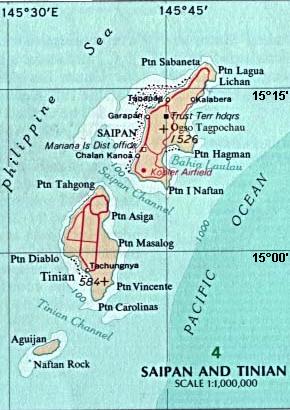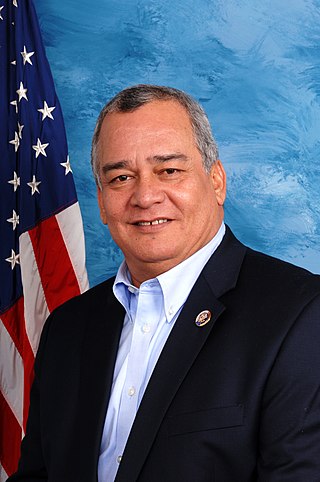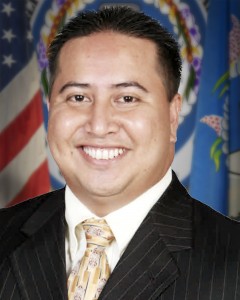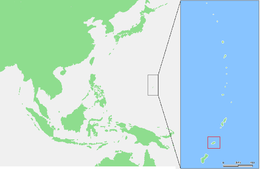
Saipan is the largest island and capital of the Northern Mariana Islands, a commonwealth of the United States in the western Pacific Ocean. According to 2020 estimates by the United States Census Bureau, the population of Saipan was 43,385, a decline of 10% from its 2010 count of 48,220.

Tinian is one of the three principal islands of the Commonwealth of the Northern Mariana Islands (CNMI). Together with uninhabited neighboring Aguiguan, it forms Tinian Municipality, one of the four constituent municipalities of the Northern Marianas. Tinian's largest village is San Jose. Tinian is just south of the most inhabited island Saipan, but north of the populated Rota to the south. The island is home to many WW2 historical sites, cattle ranches, and beaches. There was a 5-star casino that operated from 1998 to 2015; remaining are other hotels/resorts and a golf course. The main access to Saipan is by a short airplane ride from the international airport, or by a charter boat.

Benigno Repeki Fitial is a Northern Marianan politician who served was the sixth governor of the Northern Mariana Islands. The second longest-serving governor in CNMI history, Fitial was elected on November 6, 2005, assumed office on January 9, 2006, and was re-elected to a (five-year) second term in 2009. He was impeached by the CNMI House of Representatives on February 11, 2013, and was scheduled to face trial before the CNMI Senate to determine if he should be removed from office. He resigned on February 20, 2013, after 7 years, 1 month, and 11 days in office.

Scouting in the Northern Mariana Islands is in a state of development and growth. Scouting has existed in the islands since at least the 1970s, and may have been developed as early as the 1950s.
Songsong is the second largest village on the island of Rota, Northern Mariana Islands, United States. As of 2000, its population is 593. Songsong is located along the southern coast, in a narrow peninsula. The village's most recognizable landmark is Mt. Taipingot, more commonly known as Wedding Cake Mountain because of its resemblance to a layered wedding cake. The word songsong is a Chamorro word meaning "village, people." The village itself is subdivided into several districts:
Chalan Piao is a village on the southwestern area of Saipan. Commonwealth of the Northern Mariana Islands. It is bordered on the north by Chalan Kanoa, on the east by As Perdido village and on the south by San Antonio village. To the west is the Pacific Ocean.

Commonwealth of the Northern Mariana Islands Public School System is a school district serving the Northern Mariana Islands, a United States territory.
Education in the Northern Mariana Islands is linked to the United States Department of Education as the Northern Mariana Islands form part of the United States Commonwealth. This encompasses the sectors of pre-K, elementary schools, middle schools, high schools and college education. The main governing body in the region is the Commonwealth of the Northern Mariana Islands Public School System whose headquarters are located on Capital Hill, Saipan. Currently, there are 20 schools operating within the CNMI PSS. There are also a number of private and home school systems operating in the region. The educational system follows a similar model to the United States educational system whereby children between the ages of 5-16 are mandated to attend formal school. All educational institutions, systems and budget are governed first by the US Board of Education, followed by the Northern Mariana Islands State Board of Education, which was established in 1988 as a requirement of the Northern Mariana Islands Constitution.

Gregorio Kilili Camacho Sablan is a Northern Mariana Islander politician and former election commissioner. Elected in 2008, Sablan became the first delegate to the United States House of Representatives from the Commonwealth of the Northern Mariana Islands. Sablan is the only Chamorro member of Congress.

The 2009 Northern Mariana Islands general election was held on Saturday, November 7, 2009. This was the last general election to be held on a odd year. This election also saw the extension all office holding officials by one year to move the elections to even-years, corresponding with the elections of other federal and state offices, including the nationwide United States House of Representatives elections and the United States general elections. This election also oversaw the first run-off to be held in the Northern Mariana Islands, which were held on Monday, November 23, 2009. Benigno Fitial became the first governor to win a second term since 1985 and the first time a candidate won a majority since 1993 thanks to the newly implemented run-off voting system.
Sinapalo or Sinapalu is a village on the island of Rota in the Northern Mariana Islands. The village is the largest settlement on the island, located south of the island's airport, Rota International Airport, close to the center of the island.
Rita Hocog Inos was a Northern Mariana Island educator, activist and politician. Inos was the former Education Commissioner of the Northern Marianas school system and served on the Northern Marianas College Board of Regents. Inos was a two-time candidate for Lieutenant Governor of the Northern Mariana Islands, becoming the first woman to seek election to that particular office.
Same-sex marriage was legalized in the Northern Mariana Islands by the U.S. Supreme Court's landmark ruling in Obergefell v. Hodges on June 26, 2015, which struck down same-sex marriage bans nationwide. On June 29, Governor Eloy Inos issued a statement hailing the decision as "historic", and said he would work with the Attorney General and local officials to bring the U.S. territory into compliance. Attorney General Edward Manibusan issued a memorandum on June 30 confirming that the territory was bound by the court decision and said that marriage license forms would be changed to include same-sex couples.
Victor Borja Hocog is a Northern Marianan politician. He served as the President of the Northern Mariana Islands Senate from January 14, 2019 to January 11, 2021, and previously from January 12, 2015 to December 29, 2015. He also served as the 11th Lieutenant Governor of the Northern Mariana Islands from December 29, 2015 to January 14, 2019.

The 2018 Northern Mariana gubernatorial election took place on Tuesday, November 13, 2018, to elect the Governor of the Northern Mariana Islands and the Lieutenant Governor of the Northern Mariana Islands to a four-year term in office. Incumbent Republican governor Ralph Torres, who ascended to governorship in December 2015 following the death of Governor Eloy Inos, sought election to a full term.

Star Marianas Air, Inc. is a U.S. commuter airline headquartered at Tinian International Airport in Tinian Municipality, Northern Mariana Islands. It operates scheduled and charter passenger service in the Commonwealth of the Northern Mariana Islands and Guam, both U.S. territories in the Pacific Ocean.
Dr. Rita Hocog Inos Jr./Sr. High School (RHI), formerly Rota Jr./Sr. High School, is a secondary school in Songsong on the island of Rota in the Northern Mariana Islands, and a part of the CNMI Public School System. It is the island's sole secondary school.
Joeten-Kiyu Public Library is the State Library of the Commonwealth of the Northern Mariana Islands.
Don Allen Farrell is an educator, local historian and author based on the island of Tinian in the Commonwealth of the Northern Mariana Islands (CNMI). He is known for his research and publications on the history of the Mariana Islands with an emphasis on World War II.
Paul Atalig Manglona is a member of the Northern Mariana Islands Senate from Rota. Manglona was appointed to the Senate on February 10, 2016 to succeed Victor Hocog upon Hocog’s elevation to Lieutenant Governor of the Northern Mariana Islands.

















